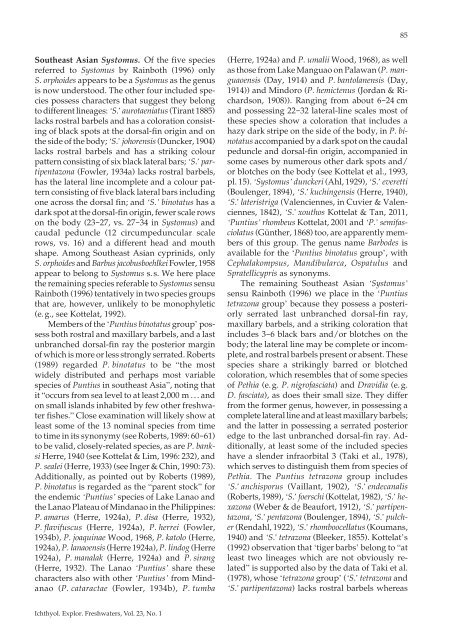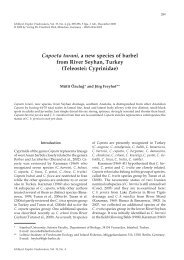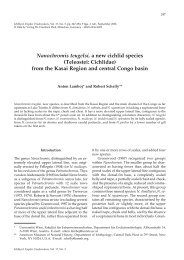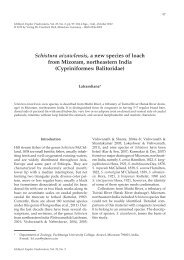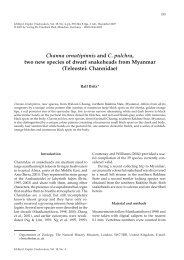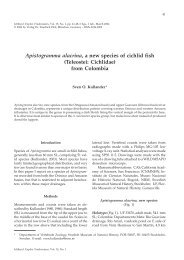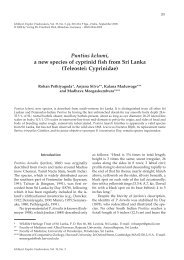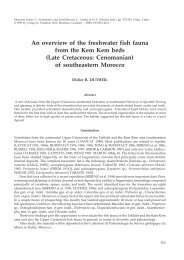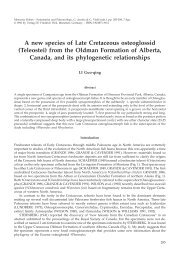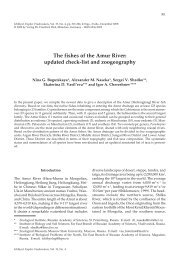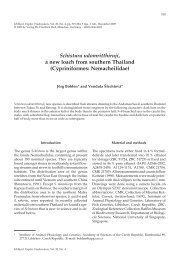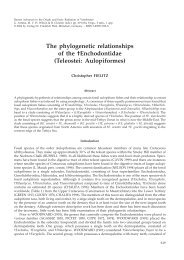A synopsis of the South Asian fishes referred to Puntius - Verlag Dr ...
A synopsis of the South Asian fishes referred to Puntius - Verlag Dr ...
A synopsis of the South Asian fishes referred to Puntius - Verlag Dr ...
You also want an ePaper? Increase the reach of your titles
YUMPU automatically turns print PDFs into web optimized ePapers that Google loves.
Sou<strong>the</strong>ast <strong>Asian</strong> Sys<strong>to</strong>mus. Of <strong>the</strong> five species<br />
<strong>referred</strong> <strong>to</strong> Sys<strong>to</strong>mus by Rainboth (1996) only<br />
S. orphoides appears <strong>to</strong> be a Sys<strong>to</strong>mus as <strong>the</strong> genus<br />
is now unders<strong>to</strong>od. The o<strong>the</strong>r four included species<br />
possess characters that suggest <strong>the</strong>y belong<br />
<strong>to</strong> different lineages: ‘S.’ aurotaeniatus (Tirant 1885)<br />
lacks rostral barbels and has a coloration consisting<br />
<strong>of</strong> black spots at <strong>the</strong> dorsal-fin origin and on<br />
<strong>the</strong> side <strong>of</strong> <strong>the</strong> body; ‘S.’ johorensis (Duncker, 1904)<br />
lacks rostral barbels and has a striking colour<br />
pattern consisting <strong>of</strong> six black lateral bars; ‘S.’ partipentazona<br />
(Fowler, 1934a) lacks rostral barbels,<br />
has <strong>the</strong> lateral line incomplete and a colour pattern<br />
consisting <strong>of</strong> five black lateral bars including<br />
one across <strong>the</strong> dorsal fin; and ‘S.’ binotatus has a<br />
dark spot at <strong>the</strong> dorsal-fin origin, fewer scale rows<br />
on <strong>the</strong> body (23-27, vs. 27-34 in Sys<strong>to</strong>mus) and<br />
caudal peduncle (12 circumpedun cular scale<br />
rows, vs. 16) and a different head and mouth<br />
shape. Among Sou<strong>the</strong>ast <strong>Asian</strong> cyprinids, only<br />
S. orphoides and Barbus jacobusboehlkei Fowler, 1958<br />
appear <strong>to</strong> belong <strong>to</strong> Sys<strong>to</strong>mus s. s. We here place<br />
<strong>the</strong> remaining species referable <strong>to</strong> Sys<strong>to</strong>mus sensu<br />
Rainboth (1996) tentatively in two species groups<br />
that are, however, unlikely <strong>to</strong> be monophyletic<br />
(e. g., see Kottelat, 1992).<br />
Members <strong>of</strong> <strong>the</strong> ‘<strong>Puntius</strong> binotatus group’ possess<br />
both rostral and maxillary barbels, and a last<br />
unbranched dorsal-fin ray <strong>the</strong> posterior margin<br />
<strong>of</strong> which is more or less strongly serrated. Roberts<br />
(1989) regarded P. binotatus <strong>to</strong> be “<strong>the</strong> most<br />
widely distributed and perhaps most variable<br />
species <strong>of</strong> <strong>Puntius</strong> in sou<strong>the</strong>ast Asia”, noting that<br />
it “occurs from sea level <strong>to</strong> at least 2,000 m . . . and<br />
on small islands inhabited by few o<strong>the</strong>r freshwater<br />
<strong>fishes</strong>.” Close examination will likely show at<br />
least some <strong>of</strong> <strong>the</strong> 13 nominal species from time<br />
<strong>to</strong> time in its synonymy (see Roberts, 1989: 60-61)<br />
<strong>to</strong> be valid, closely-related species, as are P. banksi<br />
Herre, 1940 (see Kottelat & Lim, 1996: 232), and<br />
P. sealei (Herre, 1933) (see Inger & Chin, 1990: 73).<br />
Additionally, as pointed out by Roberts (1989),<br />
P. binotatus is regarded as <strong>the</strong> “parent s<strong>to</strong>ck” for<br />
<strong>the</strong> endemic ‘<strong>Puntius</strong>’ species <strong>of</strong> Lake Lanao and<br />
<strong>the</strong> Lanao Plateau <strong>of</strong> Mindanao in <strong>the</strong> Philippines:<br />
P. amarus (Herre, 1924a), P. disa (Herre, 1932),<br />
P. flavifuscus (Herre, 1924a), P. herrei (Fowler,<br />
1934b), P. joaquinae Wood, 1968, P. ka<strong>to</strong>lo (Herre,<br />
1924a), P. lanaoensis (Herre 1924a), P. lindog (Herre<br />
1924a), P. manalak (Herre, 1924a) and P. sirang<br />
(Herre, 1932). The Lanao ‘<strong>Puntius</strong>’ share <strong>the</strong>se<br />
characters also with o<strong>the</strong>r ‘<strong>Puntius</strong>’ from Mindanao<br />
(P. cataractae (Fowler, 1934b), P. tumba<br />
Ichthyol. Explor. Freshwaters, Vol. 23, No. 1<br />
85<br />
(Herre, 1924a) and P. umalii Wood, 1968), as well<br />
as those from Lake Manguao on Palawan (P. manguaoensis<br />
(Day, 1914) and P. ban<strong>to</strong>lanensis (Day,<br />
1914)) and Mindoro (P. hemictenus (Jordan & Richardson,<br />
1908)). Ranging from about 6-24 cm<br />
and possessing 22-32 lateral-line scales most <strong>of</strong><br />
<strong>the</strong>se species show a coloration that includes a<br />
hazy dark stripe on <strong>the</strong> side <strong>of</strong> <strong>the</strong> body, in P. binotatus<br />
accompanied by a dark spot on <strong>the</strong> caudal<br />
peduncle and dorsal-fin origin, accompanied in<br />
some cases by numerous o<strong>the</strong>r dark spots and/<br />
or blotches on <strong>the</strong> body (see Kottelat et al., 1993,<br />
pl. 15). ‘Sys<strong>to</strong>mus’ dunckeri (Ahl, 1929), ‘S.’ everetti<br />
(Boulenger, 1894), ‘S.’ ku chingensis (Herre, 1940),<br />
‘S.’ lateristriga (Valen ciennes, in Cuvier & Valenciennes,<br />
1842), ‘S.’ xou thos Kottelat & Tan, 2011,<br />
‘<strong>Puntius</strong>’ rhombeus Kottelat, 2001 and ‘P.’ semifasciolatus<br />
(Gün<strong>the</strong>r, 1868) <strong>to</strong>o, are apparently members<br />
<strong>of</strong> this group. The genus name Barbodes is<br />
available for <strong>the</strong> ‘<strong>Puntius</strong> binotatus group’, with<br />
Cephalakompsus, Mandibularca, Ospatulus and<br />
Spratellicypris as synonyms.<br />
The remaining Sou<strong>the</strong>ast <strong>Asian</strong> ‘Sys<strong>to</strong>mus’<br />
sensu Rainboth (1996) we place in <strong>the</strong> ‘<strong>Puntius</strong><br />
tetrazona group’ because <strong>the</strong>y possess a posteriorly<br />
serrated last unbranched dorsal-fin ray,<br />
maxillary barbels, and a striking coloration that<br />
includes 3-6 black bars and/or blotches on <strong>the</strong><br />
body; <strong>the</strong> lateral line may be complete or incomplete,<br />
and rostral barbels present or absent. These<br />
species share a strikingly barred or blotched<br />
coloration, which resembles that <strong>of</strong> some species<br />
<strong>of</strong> Pethia (e. g. P. nigr<strong>of</strong>asciata) and <strong>Dr</strong>avidia (e. g.<br />
D. fasciata), as does <strong>the</strong>ir small size. They differ<br />
from <strong>the</strong> former genus, however, in possessing a<br />
complete lateral line and at least maxillary barbels;<br />
and <strong>the</strong> latter in possessing a serrated posterior<br />
edge <strong>to</strong> <strong>the</strong> last unbranched dorsal-fin ray. Additionally,<br />
at least some <strong>of</strong> <strong>the</strong> included species<br />
have a slender infraorbital 3 (Taki et al., 1978),<br />
which serves <strong>to</strong> distinguish <strong>the</strong>m from species <strong>of</strong><br />
Pethia. The <strong>Puntius</strong> tetrazona group includes<br />
‘S.’ anchisporus (Vaillant, 1902), ‘S.’ endecanalis<br />
(Roberts, 1989), ‘S.’ foerschi (Kottelat, 1982), ‘S.’ hexazona<br />
(Weber & de Beaufort, 1912), ‘S.’ partipentazona,<br />
‘S.’ penta zona (Boulenger, 1894), ‘S.’ pulcher<br />
(Rendahl, 1922), ‘S.’ rhomboocellatus (Koumans,<br />
1940) and ‘S.’ te trazona (Bleeker, 1855). Kottelat’s<br />
(1992) observation that ‘tiger barbs’ belong <strong>to</strong> “at<br />
least two lineages which are not obviously related”<br />
is supported also by <strong>the</strong> data <strong>of</strong> Taki et al.<br />
(1978), whose ‘tetrazona group’ (‘S.’ tetrazona and<br />
‘S.’ partipentazona) lacks rostral barbels whereas


